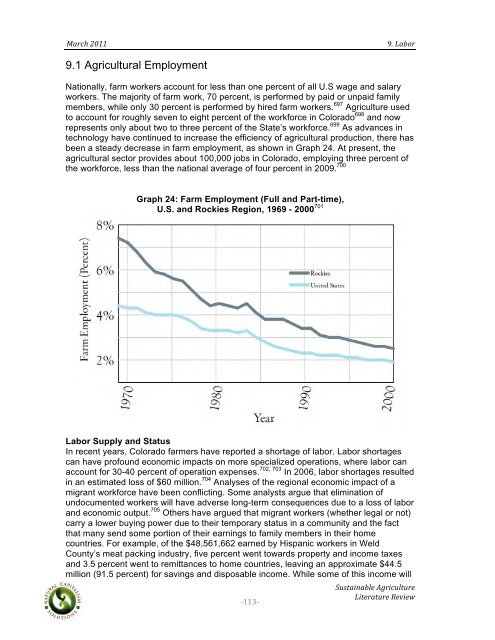Sustainable Agriculture Literature Review - Boulder County
Sustainable Agriculture Literature Review - Boulder County
Sustainable Agriculture Literature Review - Boulder County
Create successful ePaper yourself
Turn your PDF publications into a flip-book with our unique Google optimized e-Paper software.
! !!<br />
"#$%&!'())!! !!!!!!!!!!!!!!!!!!!!!!!!!!!!!!!!!!!!!!!!!!!!!!!!!!!!!!!!!!!!!!!!!!!!!!!!!!!!!!!!!!G+!9#6-$!<br />
9.1 Agricultural Employment<br />
Nationally, farm workers account for less than one percent of all U.S wage and salary<br />
workers. The majority of farm work, 70 percent, is performed by paid or unpaid family<br />
members, while only 30 percent is performed by hired farm workers. 697 <strong>Agriculture</strong> used<br />
to account for roughly seven to eight percent of the workforce in Colorado 698 and now<br />
represents only about two to three percent of the State’s workforce. 699 As advances in<br />
technology have continued to increase the efficiency of agricultural production, there has<br />
been a steady decrease in farm employment, as shown in Graph 24. At present, the<br />
agricultural sector provides about 100,000 jobs in Colorado, employing three percent of<br />
the workforce, less than the national average of four percent in 2009. 700<br />
!<br />
Graph 24: Farm Employment (Full and Part-time),<br />
U.S. and Rockies Region, 1969 - 2000 701<br />
Labor Supply and Status<br />
In recent years, Colorado farmers have reported a shortage of labor. Labor shortages<br />
can have profound economic impacts on more specialized operations, where labor can<br />
account for 30-40 percent of operation expenses. 702, 703 In 2006, labor shortages resulted<br />
in an estimated loss of $60 million. 704 Analyses of the regional economic impact of a<br />
migrant workforce have been conflicting. Some analysts argue that elimination of<br />
undocumented workers will have adverse long-term consequences due to a loss of labor<br />
and economic output. 705 Others have argued that migrant workers (whether legal or not)<br />
carry a lower buying power due to their temporary status in a community and the fact<br />
that many send some portion of their earnings to family members in their home<br />
countries. For example, of the $48,561,662 earned by Hispanic workers in Weld<br />
<strong>County</strong>’s meat packing industry, five percent went towards property and income taxes<br />
and 3.5 percent went to remittances to home countries, leaving an approximate $44.5<br />
million (91.5 percent) for savings and disposable income. While some of this income will<br />
"'')"<br />
!,342#.5#6/1!78$.%3/23$1!<br />
9.21$#23$1!:1;.1
















